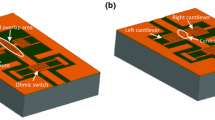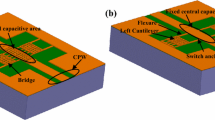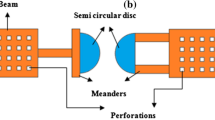Abstract
This paper presents a new type of capacitive shunt RF-MEMS switch. In the proposed design, float metal concept has been utilized to make the asymmetric structure on either side of the transmission line to implement the switch. This novel structure is used to inductively tune the isolation in C, X and Ku bands. Isolation peaks of 42.63, 44.22 and 47.75 dB has been observed at 7.2, 8.8 and 16.5 GHz when left, right or both cantilevers are electro-statically actuated in the down-state respectively, whereas conventional switch has peak only in X-band. Switch shows an insertion loss better than 0.10 dB, a return loss below 23.93 dB up to 25 GHz as compared to 0.90 dB insertion loss and 8.02 dB of return loss in case of conventional device. Further, improvement of around 5 times in bandwidth, 50 % in the pull-in voltage and 16.7 % in device area have also been observed. The designed switch can be useful at device and sub-system level for the future multi-band communication applications.
Similar content being viewed by others
Avoid common mistakes on your manuscript.
1 Introduction
In recent years, MEMS technology based devices have been proven valuable for RF applications. New wireless standards are coming-up requiring devices with multi-band functionality to ensure reconfigurability of front without compromising the performance. RF-MEMS is becoming an attractive technology for the above cited purpose. Amongst the different device switches have gained much attention because of excellent isolation, low insertion loss, high linearity, less power consumption compared to solid state counterpart (Brown 1998; Tilmans et al. 2003; Rebeiz 2003; Rangra 2005). RF-MEMS switches are used as a building block in many telecommunication systems, including phased array antenna (Armenta et al. 2012), phase shifters (Rebeiz et al. 2002; Dey and Koul 2012; Razeghi and Ganji 2013), switch matrix (Fomani and Mansour 2009), multi-port switches (DiNardo et al. 2006; Kang et al. 2009) and tunable filters (Peroulis et al. 2000; Entesari and Rebeiz 2005; Guo and Jin 2011). However, device performance requirement becomes more critical when switches are used in large numbers because of the combined effect of multiple switches. A number of structures have been reported in the literature for the capacitive switches having good RF performance in a single band, moderate pull-in voltage, but lags in multi-band functionality e.g. (Muldavin and Rebeiz 2000a; Rebriz and Muldavin 2001; Rangra et al. 2005; Fouladi and Mansour 2010; Bansal et al. 2013; Angira et al. 2013). In another approach combination of switches like the series and shunt are used to make multi-band devices, but more insertion loss and the large chip area make them unsuitable for future compact systems (Muldavin and Rebeiz 2000b, 2001).
In the presented paper, a novel design based on the float metal concept has been proposed. Insertion loss has been improved by reducing the capacitance in the up-state. Isolation characteristics is tuned in different bands by changing the inductance in the down-state. Further, a conventional switch has been designed and compared with proposed device. Figure 1a, b shows the model of the designed switches.
2 Device description and working
As typical of shunt configuration the input and output RF ports are physically connected to each other and therefore normally switch is ON. Broadside switch is based on a 50 Ω CPW. In conventional approach switch is implemented with a bridge structure having four flexures whereas proposed design consist of cantilever structures on either side of transmission line. In order to realize the multi-band functionality, inductance value has been kept different on either side cantilevers through asymmetric structures. The switch design parameters are listed in Table 1.
2.1 Switch working
The different states for the proposed device operation are shown in Fig. 2a–d. In state 1 with both cantilevers in the up position, the switch is ON and shows insertion loss. OFF state can be achieved by pulling down the left, right or both cantilever in the down position through electro-static actuation. Figure 2b shows the isolation state when the right beam connects ground to the float central capacitive area. As the left cantilever is having more inductance than the right, switching it down shift the isolation peak to a lower frequency. This state is shown in Fig. 2c. Finally, when all beams are in down position inductance becomes even less and shifts the isolation peak to a much higher frequency.
3 RF response
In shunt capacitive switch, RF response is the function of the ratio of up-state capacitance to the down-state capacitance. Equations (1, 2 and 3) show the capacitance in up, down and their ratio.
where Aup = capacitive overlap area in up-state, Adown = capacitive overlap area in down-state, \(\upepsilon_{\rm r}\) = relative permittivity, Cup = capacitance in the up-state of the switch, Cdown = down-state capacitance of the switch and Cratio = ratio of the capacitance in down-state to the up-state. A high capacitance ratio is desirable for good RF response.
3.1 ON state response
The capacitance in the up-state of switch can be reduced by utilizing the float metal concept (Giacomozzi et al. 2008; Angira and Rangra 2014). The proposed device is having Aup_pro = 70 × 50 µm2 whereas conventional Aup_con = 230 × 90 µm2. Thus, from Eq. (4) Cup_Pro is around 6 times less than the Cup_Con. In order to determine the RF response electromagnetic simulation has been performed in Ansys HFSS™. Insertion loss of 0.01–0.10 and 0.02–0.90 dB have been observed in case of presented design and conventional switch respectively for the frequency range from 1 to 25 GHz as shown in Fig. 3. Return loss is also improved from 35.50–8.02 to 51.51–23.93 dB for the novel switch as compared to conventional design in the frequency range from 1 to 25 GHz as shown in Fig. 4.
3.2 OFF state response
In addition to reducing the up-state capacitance float metal concept also allows to make asymmetric structures on either side of the transmission line and thus isolation peaks can be tuned to different bands. Figure 5 shows the isolation characteristics of both devices. A peak value of 42.63, 44.22 dB has been observed at 7.2, 8.8 GHz when left and right cantilevers are electro-statically actuated in the down-state respectively. As resonant frequency is the function of the capacitance and inductance, pulling down the both cantilevers shift the isolation peak in Ku-band. A peak value of 47.75 dB has been obtained at 16.5 GHz. The conventional device has isolation peak only in X-band.
Return loss during OFF state for both devices has been shown in Fig. 6. Return loss is minimum when isolation peak value is observed. As bridge structure is changed into cantilevers, inductance in either side will increase and thus the central capacitive area has been reduced by 56.52 % in the proposed design, leading to the overall reduction of about 16.7 % in the switch size.
3.3 Switches bandwidth
The switch bandwidth can be calculated from the lower and the upper operating frequency. Lower frequency (fL) is limited by the minimum isolation, whereas the upper frequency (fU) either by maximum insertion loss or minimum isolation. For bandwidth calculation an acceptable maximum insertion loss of 0.2 dB and minimum isolation of 20 dB has been chosen. It is observed from Fig. 7 that upper operating frequency is limited by insertion loss. Switch has fL = 6.1 GHz and fU = 10.3 GHz. This results in a bandwidth of 4.2 GHz in conventional design. Figure 8 shows the bandwidth (fU − fL = 13.7 GHz) for the proposed device when both cantilevers are in down-state. In case of left cantilever down a bandwidth of 2.7 GHz has been obtained in C and X bands as shown in Fig. 9. In right cantilever case a bandwidth of around 3.9 GHz has been achieved as shown in Fig. 10.
In electro-mechanical response pull-in voltage is determined by doing FEM simulation in coventoreware(R). The conventional switch has pull-in voltage of 13 V, whereas in the proposed design left and right cantilevers have pull-in voltage of 5.75, 6.75 V respectively as shown in Fig. 11.
4 Conclusion
A new type of capacitive shunt RF-MEMS switch has been proposed and investigated. The considerable improvement in insertion loss has been achieved as compared to the conventional switch by utilizing the float metal concept. Isolation peaks have been shifted in different bands by varying the down-state inductance through asymmetric structures. The capacitive overlap area is reduced by 56.52 %, leading to the overall reduction of about 16.7 % in the switch size, whereas pull-in voltage is reduced by 50 % as compared to the conventional switch. Further, improvement of around 5 times in bandwidth has also been observed. The designed switch can be useful for the future front-end reconfigurable devices and sub-systems.
References
Angira M, Rangra K (2014) Design and investigation of a low insertion loss, broadband, enhanced self and hold down power RF-MEMS switch. J Microsyst Technol. doi:10.1007/s00542-014-2188-6
Angira M, Sundaram GM, Rangra KJ, Bansal D, Kaur M (2013) On the investigation of an interdigitated, high capacitance ratio shunt RF-MEMSswitch for X-band applications. In: Proceeding of NSTI Nanotech, Washington 2, pp 189–192
Armenta CJA, Porter S, Marvin A (2012) Reconfigurable phased array antennas with RF-MEMS on a PCB substrate. In: Proceeding of antennas and propagation, Loughborough, pp 1–5
Bansal D, Kumar A, Sharma A, Kumar P, Rangra KJ (2013) Design of novel compact anti-stiction and low insertion loss RF MEMS switch. J Microsyst Technol. doi:10.1007/s00542-013-1812-1S
Brown ER (1998) RF-MEMS Switches for reconfigurable integrated circuits. IEEE Trans Microw Theory Tech 46:1868–1880
Dey S, Koul SK (2012) Design and development of a surface micro-machined push–pull-type true-time-delay phase shifter on an alumina substrate for Ka-band T/R module application. J Micromech Microeng 22:125006–1250026
DiNardo S, Farinelli P, Giacomozzi F, Mannocchi G, Marcelli R, Margesin B, Mezzanotte P Mulloni, V Russer, Sorrentino R, Vitulli F, Vietzorreck L (2006) Broadband RF-MEMS Based SPDT. In: Proceeding of European microwave conference, Manchester, pp 1727–1730
Entesari K, Rebeiz GM (2005) Differential 4-bit 6.5–10 GHz RF MEMS tunable filter. IEEE Trans Microw Theory Tech 53:1103–1110
Fomani AA, Mansour RR (2009) Miniature RF MEMS switch matrices. In: Proceeding of IEEE MTT-S microwave symposium digest, Boston, pp 1221–1224
Fouladi S, Mansour RR (2010) Capacitive RF MEMS switches fabricated in 0.35 μm CMOS technology. IEEE Trans Microw Theory Tech 58:478–485
Giacomozzi F, Calaza C, Colpo S, Mulloni V, Collini A, Margesini B, Farinelli P, Casini F, Marcelli R, Mannocchi G, Vietzorreck L (2008) Development of high con coff ratio RF MEMS shunt switches. Roman J of Inf Sci Tech 11:143–151
Guo XL, Jin Y (2011) Miniature and tunable millimeter-wave lowpass filter with MEMS switch. J Solid State Electro 63:145–148
Kang S, Kim HC, Chun K (2009) A low-loss, single-pole, four-throw RF MEMS switch driven by a double stop comb drive. J Micromech Microeng 19:035011–035021
Muldavin JB, Rebeiz GM (2000a) High-isolation CPW MEMS shunt switches—part 1: modeling. IEEE Trans Microw Theory Tech 48:1045–1052
Muldavin JB, Rebeiz GM (2000b) Novel series and shunt MEMS switch geometries for X-band applications. In: Proceeding of European microwave conference, Paris, pp 1–4
Muldavin JB, Rebeiz GM (2001) Novel DC-contact MEMS shunt switches and high-isolation series/shunt designs. In: Proceeding of European microwave conference, London, pp 1–3
Peroulis D, Pacheco S, Sarabandi M, Katehi LPB (2000) MEMS devices for high isolation switching and tunable filtering. IEEE MTT-S Microw Symp Dig, Boston, pp 1217–1220
Rangra K (2005) Electrostatic low actuation voltage RF MEMS switches for telecommunications, Ph.D. Thesis, Department of Information Technology, University of Trento, Trento
Rangra K, Margesin B, Lorenzelli L, Giacomozzi F, Collinni C, Zen M, Gsonicini S, Tin LD, Gaddi R (2005) Symmetric toggle switch—a new type of rf MEMS switch for telecommunication applications: design and fabrication. Sens Actuators, A 123–124:505–514
Razeghi A, Ganji BA (2013) A novel design of RF MEMS dual band phase shifter. J Microsyst Technol. doi:10.1007/s00542-013-1921-x
Rebeiz GM (2003) RF MEMS theory, design and technology, 2nd edn. Wiley, New Jersy
Rebeiz GM, Tan GL, Hayden JS (2002) RF- MEMS phase shifters: design and applications. IEEE Microw Mag 3:72–81
Rebriz GM, Muldavin JB (2001) RF-MEMS switches and switch circuits. IEEE Microw Mag 2:59–71
Tilmans HAC, Raedt WD, Beyne E (2003) MEMS for wireless communications from RF-MEMS components to RF-MEMS SiP. J Micromech Microeng 13:139–163
Author information
Authors and Affiliations
Corresponding author
Rights and permissions
About this article
Cite this article
Angira, M., Rangra, K. Performance improvement of RF-MEMS capacitive switch via asymmetric structure design. Microsyst Technol 21, 1447–1452 (2015). https://doi.org/10.1007/s00542-014-2222-8
Received:
Accepted:
Published:
Issue Date:
DOI: https://doi.org/10.1007/s00542-014-2222-8















